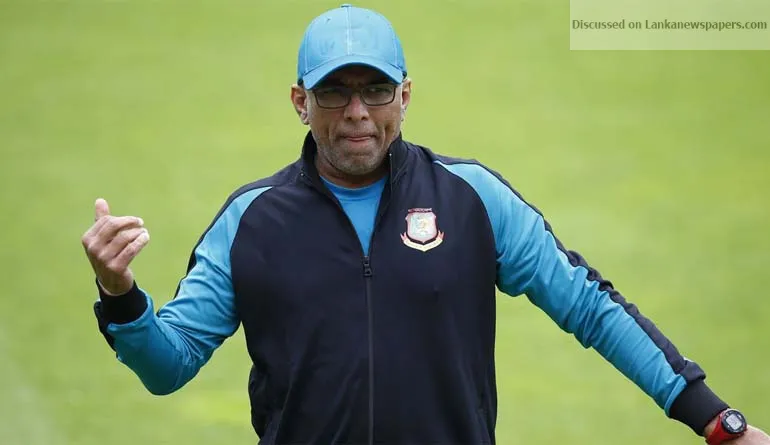
Uncategorized
In 2011, it seemed inevitable that Hathurusingha would be elevated to the national team, following the departure of Trevor Bayliss, but Sri Lanka’s board politics ensured that Sangakkara did not get the coach he wanted.
In
international cricket, you cannot be a team in transition for too long. The loss of stars, or big players, especially if they go chronologically close to each other, is bound to have a major impact. But the test of the robustness of a country’s cricketing ecosystem, is how quickly they can absorb these losses and bounce back. For Sri Lanka, the transition phase from the departure of the likes of Kumar Sangakkara, Mahela Jayawardene and Tillakaratne Dilshan has been far too long for anyone’s liking.
Several reasons are attributed to this, from inconsistency in selection to a weak domestic
cricket structure diluted by the presence of far too many teams for a small talent pool. Yet, the one thing possibly lacking was the presence of one man in charge with a clear vision of what needed to be done and the
power to get this implemented. With the arrival of Chandika Hathurusingha as coach, lured away from his position in Bangladesh, this gap has been filled. The results are yet to show this, and it is too early to suggest that Sri Lanka have turned a corner, but at least they now know what must be done, and have a coach who will do everything in his
power to ensure it is done.
But, what’s so special about Hathurusingha, an opening batsman who played 26 Tests achieving an average of 35.65 between 1991 and 1999?
Let’s start at the beginning. Studying at Veluwana, a
school that encouraged
cricket, but not at any serious level, young Hathurusingha, who comes from a modest background, needed more, if something was to made of his talent. Fortunately for the little boy had a coach in Tom Depp, who
had a plan. Hathurusingha was taken to Tamil Union and handed over to S Skandakumar, who took the then 14-year-old under wing. "When Chandika came to me, he was only a little boy, but watching him bat you could see that what the coaches were saying about him was right," Skandakumar, now Sri Lanka’s High Commissioner to
Australia, told the ‘Economic Times’ from Canberra.
"While the skill was there, he needed a bit of guidance, and I was fortunate to be in a position to provide it."
Skanda, as he is popularly known, is being modest. Not only did he help Hathurusingha with his batting, Skanda provided financial assistance, placed the boy in Ananda College, one of the premier cricketing schools in the country, he took a personal interest in the young man’s development.
"The one thing I remember was that Chandika struggled with English then. So, I would make him read the English newspapers in the morning and meet me for a walk at Tamil Union in the evening," recalls Skanda. "He would then have to tell me what all he had read, all in English."
Hathurusingha puts the help he received in sharp focus. "He was like a father figure to me," says Hathurusingha. "Not only
cricket, he took a great interest in making me a better person. He has been a great mentor and a thorough gentleman."
At Ananda, Hathurusingha struggled to break into the
school’s first eleven, not because of a lack of talent, but because half the team was filled with the established Ranatungas. Where one door closed, however, another opened.
"A
Sri Lankan Under-19 team was set to tour England," recalls Skanda.
"There was a long-list of 60 and when it was pruned to 30, Hathurusingha was left out. I found this odd as there were cricketers with far less talent in the list. So I requested the coach to have another look at the boy. He did, Chandika was back in the 30 and in the two trial matches he scored half-centuries and was on the plane to England." It’s extremely unusual, to say the least, that a player makes his national Under-19 debut before he has even broken into his
school team.
Having got the right boosts just when he needed them, from men such as Skanda, Hathurusingha was determined not to squander the opportunity, understanding that he was playing not just for himself, but for those who had stuck their necks out for him. He rose steadily up the ranks and enjoyed a strong career, but his entry to coaching was anything but straightforward.
Moving from Tamil Union to Moors in 2002 as player-coach, Hathurusingha took the unfancied team, with virtually no big names, to the national title. This caught the attention, and a gig as national coach of the United Arab Emirates team followed.
Once more, it took an external hand to intervene, this time in the form of K. Mathivanan, a vice president of Sri Lanka
Cricket. Mathivanan travelled to the UAE and convinced Hathurusingha that his country needed him, as coach of the A team. Under Hathurusingha’s guidance the Sri Lanka A team
travelled to South Africa, narrowly losing the unofficial Tests and winning the limited-overs matches.
In 2011, it seemed inevitable that Hathurusingha would be elevated to the national team, following the departure of Trevor Bayliss, but Sri Lanka’s board politics ensured that Sangakkara did not get the coach he wanted.
Finally, in December 2017, Hathurusingha was where he belonged, as head coach of Sri Lanka. And when he took the job, it was on one condition — that Mathivanan stay on in the board as long as he was coach.
In 2018, how is that for a story of
Sri Lankan unity? A Buddhist Sinhalese helped early by a Tamil Hindu, winding up in charge the national team, while insisting another Tamil kept the boat on even keel. Economic Times





